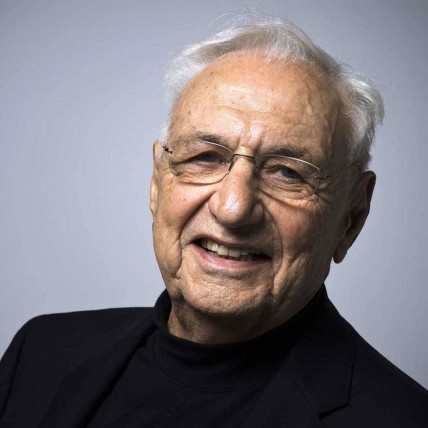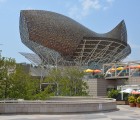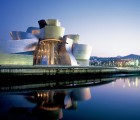Frank Gehry highlighted buildings, influences and style

Born in 1929 in Toronto (Canada) † 0000
Architectural style and influences of Frank Gehry
Frank Gehry is renowned for his distinctive and innovative architectural style, which often defies conventions and pushes the boundaries of what is possible in architecture. Here are some key characteristics of Gehry's architectural style:
Deconstructivism
Gehry is often associated with the architectural movement known as Deconstructivism, which emerged in the late 20th century. This style is characterized by fragmented forms, skewed angles, and the use of non-linear shapes. Gehry's buildings often appear to be in a state of disarray or movement, challenging traditional notions of symmetry and order.
Sculptural Forms
Gehry's buildings are like works of art in themselves, often resembling sculptures or abstract compositions. He uses bold, expressive forms that catch the eye and create a sense of drama. The exterior of his buildings can be curvaceous, angular, or a combination of both, creating a dynamic interplay of shapes and volumes.
Use of Unconventional Materials
One of Gehry's trademarks is his use of unconventional materials in his designs. He is famous for employing materials such as titanium, stainless steel, glass, and even chain-link fencing. These materials are often used in unexpected ways, creating a sense of texture, reflectivity, and lightness.
Playful and Whimsical Elements
Gehry's buildings often incorporate playful and whimsical elements that add a sense of fun and surprise. This could be seen in the incorporation of oversized sculptures, whimsical shapes, or unexpected details that break away from the traditional seriousness of architecture.
Contextual Sensitivity
Despite their bold and striking appearances, Gehry's buildings are often designed with careful consideration for their surroundings. He takes into account the urban context, neighboring buildings, and cultural or historical significance of the site. His buildings strive to complement and enhance their environments rather than dominate them.
Emphasis on Transparency
Many of Gehry's designs feature extensive use of glass, creating buildings that are transparent and open. This transparency not only allows for natural light to flood the interiors but also blurs the boundaries between inside and outside, connecting occupants with their surroundings.
Dynamic Interiors
The interior spaces of Gehry's buildings are just as dynamic and unconventional as their exteriors. He often uses flowing, open floor plans that encourage movement and interaction. The spaces are characterized by light, openness, and a sense of fluidity.
Iconic Works
Some of Gehry's most iconic works include the Guggenheim Museum Bilbao in Spain, a masterpiece of Deconstructivist architecture with its undulating titanium-clad forms; the Walt Disney Concert Hall in Los Angeles, known for its gleaming stainless steel curves; and the Fondation Louis Vuitton in Paris, an art museum with a striking sail-like structure.
Frank Gehry's architectural style is a bold and expressive fusion of Deconstructivism, sculptural forms, unconventional materials, playful elements, and contextual sensitivity. His buildings stand as sculptural works of art, pushing the boundaries of architecture and inspiring awe and wonder in those who experience them. Gehry's innovative designs have left an indelible mark on the world of architecture, redefining what is possible and challenging our perceptions of space, form, and beauty.
Highlighted buildings of Frank Gehry:
-
Frank Gehry's Fish (Barcelona)
"El Peix" (The Fish) is a striking and iconic sculpture located in Barcelona, Spain, designed by the renowned architect Frank Gehry. Here are some details about this remarkable artwork:
Design Concept
"El Peix" was commissioned as part of the urban revitalization project for the waterfront area of Barcelona in preparation for the 1992 Summer Olympics. Frank Gehry, known for his avant-garde and sculptural architecture, was chosen to create a monumental sculpture that would serve as a...

-
Guggenheim Museum Bilbao (Bilbao)
The Guggenheim Museum Bilbao, designed by the renowned architect Frank Gehry, is a masterpiece of contemporary architecture and a cultural icon in the city of Bilbao, Spain. Here are some key details about the museum and Gehry's design
Design Concept
The Guggenheim Museum Bilbao was designed by Frank Gehry and completed in 1997. Gehry's vision for the museum was to create a structure that would not only house art but also become a work of art in itself. The design aimed to evoke the...



 Santiago Calatrava
Santiago Calatrava  Ban Shigeru
Ban Shigeru  Benedetta Tagliabue
Benedetta Tagliabue  César Pelli
César Pelli  Gustave Eiffel
Gustave Eiffel 